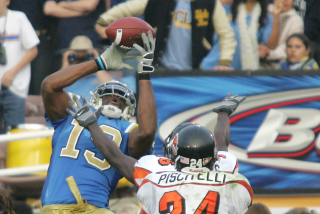Rivalry Ending Because of Money
- Share via
It isn’t even Joe Paterno’s fault that he seemed such a fossil this week while waxing historical on the dying Penn State-Syracuse rivalry. It’s just that two of his most vivid recollections were from 21 and 31 years ago and he was speaking in an age when one transcontinental home-and-home contract counts as a feud.
For those of you who just tuned in, bad blood is out in college football these days. Acrimony is out, economics is in. When the 69-year-old rivalry between Penn State and Syracuse was pronounced dead two years ago, both schools were aghast at the breakdown of one of the most enduring matches in the East. Yet, when they play each other for the final time Saturday at Beaver Stadium in University Park, Pa., most of this shock will have dissolved into resignation.
After all, Penn State has joined the Big 10, Miami has joined the Big East (football arrangements pending), and wherever schools fund football (or vice versa), such trivia as longtime associations just aren’t important or worth mourning.
“Had we been clairvoyant, two years ago, we would have had every reason to believe (Syracuse) wouldn’t have been on our schedule, anyway,” said Penn State Athletic Director Jim Tarman. “The whole thing becomes academic.”
Syracuse Coach Dick MacPherson, whose criticism of Penn State has been sardonic and ceaseless, said, “Flagship of the East, that’s what Penn State has always been. But the sails are going up and they’re heading west. You’ve got to find a new one.”
Refresher course: This issue was first raised in 1980, when Paterno led the push to form an Eastern all-sports league and was stymied by Big East basketball members Syracuse and Boston College (Pittsburgh joined in 1982). Paterno still holds a grudge. “My problem is with the Syracuse athletic director (Jake Crouthamel),” he said, even this week.
Penn State asked Syracuse in 1988 to give up one home game every 10 years (a 6-4 split, instead of 5-5), something Rutgers and Temple already had done, but Pitt had not. In exchange, Penn State offered additional guarantee money for the sixth game (the teams split roughly $250,000 last year, according to a source familiar with the contracts). But Syracuse, miffed at what it felt was poor-sister treatment, said no.
“I’m still shocked,” MacPherson said. “As a coach, you never thought it would happen.” The Syracuse program has for two decades measured itself against Penn State, and with a 48-21 upset in 1987, shot itself into national prominence. That was Syracuse’s first win over the Nittany Lions in 17 years.
“One of the most emotional games this team has ever been through,” said current Syracuse senior defensive back Rob Thomson. “We hadn’t beaten them in so long ... it just put us over the hump.”
But if this big-brother-little-brother thing was the energy of the rivalry since Penn State’s rise to power in the late ‘60s (Syracuse actually had a 20-19-3 lead through 1966, Paterno’s first year), the reasons for its demise are perfectly in step with the ‘90s: money and security. “We’re in a financial age,” Tarman said. “When Syracuse (turned us down), they were doing what they thought was in their best interest. We all do that in this day and age.”
And Penn State might not be finished dumping old enemies. Once the Lions enter the Big Ten round robin (as early as 1992), they might even drop Pitt. “We ought to take care of the people who have been our friends,” Paterno said. “Temple, Rutgers, West Virginia, the people who were willing to go along with us. The people who turned their backs on us would be Pittsburgh, Syracuse and Boston College.”
So when you listen to Paterno recalling Syracuse’s Ernie Davis preserving the ’59 game with a fourth-quarter drive or Franco Harris’ two touchdowns during Penn State’s 15-14 win in ‘69, enjoy. It’s fine to feel nostalgia tomorrow, and even a little sadness. But no outrage allowed.
More to Read
Go beyond the scoreboard
Get the latest on L.A.'s teams in the daily Sports Report newsletter.
You may occasionally receive promotional content from the Los Angeles Times.










